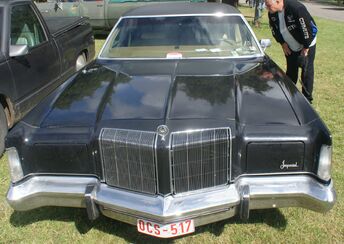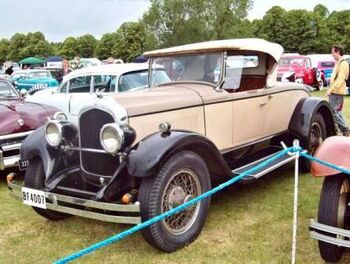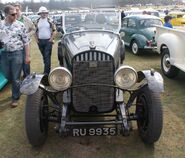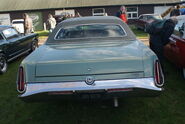
Chrysler Imperial
The Chrysler Imperial, introduced in 1926, was the company's top of the range vehicle for much of its history. Models were produced with the Chrysler name until 1954, and again from 1990 to 1993. The company tried to position the cars as a prestige marque that would rival Cadillac and Lincon. According to a feature article in AACA's magazine.
First Generation 1926–1930[]
In 1926,Walter P. Chrysler decided to attempt to compete with Cadillac and Lincoln in the luxury car field. Chrysler offered a variety of body styles: a two/four-passenger roadster(four passenger if car had the rumble seat), a four-seat coupe, five-passenger sedan and phaeton, and a seven-passenger top-of-the-linelimousine. The limo had a glass partition. The Imperial's new engine was slightly larger than the company's standard straight 6. It was a 288.6 cu in (4.7 L) six cylinder with seven bearing blocks and pressure lubrication of 92 brake horsepower (69 kW). Springs were semi-elliptic in the front. The car set a transcontinental speed record in the year it was introduced, driving more than 6,500 miles (10,460 km) in the week. The car was chosen as thepace car for the 1926Indianapolis 500. The model was designated E-80, the 80 being after the "guaranteed" 80 miles per hour (129 km/h) all-day cruising speed. Acceleration was also brisk breaking 20 seconds to 60 miles per hour (97 km/h). Four-speed transmission was added in 1930.
Series E-80 and 80 (1926-1928)[]

1928 Chrysler Imperial Roadster, at the 2009 Rally of the Giants. by Robert Knight - Flickr.com
The following year the E-80 has been further built under the name of series 80.
There were more different bodies, partly from plant production and partly by independent coachbuilders. Also 1928, this series has been offered even without major changes, parallel to the stock 80L.
The new series of E-80 was a side-valve inline six-cylinder engine introduced with 4719 cc displacement, the 92 bhp developed (68 kW) at 3000 rpm.
There were three wheelbases, 3048 mm, 3226 mm and 3378 mm. On the short chassis, a roadster, a coupe, a touring car and a 4-door sedan was offered (each with 2-5 seats), on the average, there was also a 4-door sedan and a 4-door Pullman limousine with each 7 seats.
Another 7-seater limousine and a similar Landaulet emerged on the long chassis. Curved radiator grille surround and chrome wire wheels were features that were subject to the luxurious Imperial (chroming was a new technology in the automotive industry, so far had only one nickel). 9114 cars of this type arose in 1926.
Series 80L and L IMP / IMP (1928-1930)[]
In 1929, the L series 80L as IMP ("IMP" for Imperial, not to be confused with "Imp" = (English) for imp) continued. Changes were limited to a narrower radiator grille with an automatic radiator shutter, narrower A-pillars and safety glass. The standard engine developed now 81 kW (110 hp).Appeared in 1928 in parallel to the Series 80 Series 80 L with extended to 3454 mm wheelbase chassis. The six-cylinder engine had 5069 cc displacement and gave 100 bhp from (74 kW) at 3200 rpm. Upon request, there was also this engine with an output of 82 kW (111 hp) as "Red Head". The car matched the 80th appearance in the series In addition to five factory-made bodies with 2-7 seats, there were six bodies from LeBaron, three of Dietrich and a 4-seater convertible of Locke . 1962 copies were delivered with factory-made bodies, 161 pcs with bodies of the three suppliers, totaling 2,123 pieces.
The following year the now-called IMP series was built without further changes. Overall, in the two years 2506 cars of this type originated with body work. The number of foreign karossierten vehicles is not known.
Second Generation 1931–1933[]
The Chrysler Imperial was redesigned in 1931. The car received a new engine, a 384.84-cubic inch (6308.85 cc) l8. Marketing materials for this generation of Imperial referred to the car as the "Imperial 8", in reference to the new in-line 8-cylinder engine. The engine would be found in many other Chrysler vehicles. The Custom Imperial had rust-proof fenders, automatic heater control and safety glass. The limo even came with aDictaphone. The redesign also saw the introduction of new wire wheels that became a standard wheel treatment until the 1940s. Stock car driver Harry Hartz set numerous speed records with an Imperial sedan at Daytona Beach, Florida. The 1934 to 1936 Chrysler Imperial ushered in the'Airflow' design. The car was marketed with the slogan "The car of tomorrow is here today." It featured eight passenger seating and again an eight-cylinder engine. This was the first car to be designed in a wind tunnel. Initial tests indicated that the standard car of the 1920s worked best in the wind-tunnel when pointed backwards with the curved rear deck facing forward. This led to a rethinking of the fundamental design of Chrysler's line of cars. The Airflow was an exceptionally modern and advanced car, and an unparalleled engineering success. Both engine and passenger compartment were moved forward, giving better balance, ride and roadability. An early form of unibody construction was employed, making them extremely strong. This was one of the first vehicles with fender skirts.The public was put off by the unconventional styling and did not buy the car in large numbers. The failure of the Airflow cars in the marketplace led Chrysler to be overly conservative in their styling for the next 20 years.
Series CG, CH and CL (1931-1933)[]
In the first part of the model year 1932 (July-December 1931) of the CG was offered unchanged. 3228 piece created in this 1 ½ years.In model year 1931 with the CG series appeared a completely new Imperial. He had. One side-valve eight-cylinder engine with 6306 cc engine, the 125 bhp developed (92 kW) at 3200 rpm The bodies were of the Cord L-29 inspired and showed a V-shaped tapered grille. The front seats and steering column were adjustable and the car now had four-speed transmission. The chassis had a wheelbase of 3,683 mm. There were still offered many structures with two to eight seats, some factory made, partly by independent coachbuilders like LeBaron, Derham or Murphy . Also Drauz from Germany contributed a 2-door convertible in with 5 seats.
In January 1932, the new CH Series was introduced with V-shaped windscreen, new instrument panel and sun visors inside. Only four factory-made structures (2-door roadster, 4-door sedan and 4-door convertible) were offered. The wheelbase was 3429 mm.
The parallel series of custom-made vehicles karossierte ( Custom Imperial ) was CL series. The wheelbase was 3708 mm and there were bodies available by LeBaron. Also in 1933, the series was further made.
In 1932 1402 Imperial CH Series and 220 Series Custom Imperial CL were produced. In 1933, 151 CL cars were made.
Fourth Generation 1937–1942[]
Innovations for 1937 included built-in defroster vents, safety type interior hardware (such as flexible door handles and recessed controls on the dash) and seat back padding, and fully insulated engine mounts. Brakes where 13" drums, then in 1939 they expanded to 14", but shrunk to 12" drums in 1940. Front suspension was independent. There were three Imperial models in this generation. The C-14 was the standard eight and looked much like the Chrysler Royal C-18 with a longer hood and cowl. The C-15 was the Imperial Custom and the Town Sedan Limousine, with blind rear quarter panels. This model was available by special order. The third model, C-17, was the designation for the Airflow model. They had a concealed crank for raising the windshield and the hood was hinged at the cowl and opened from the front; side hood panels were released by catches on the inside. A Custom Imperial convertible sedan was used as an official car at the Indy 500. The car pictured is Jim Martin's 1939 C-24 7 passenger limousine, believed to be the only 1939 production limo still on the road.
Series C14 and C15 (1937)[]
Was the Imperial Custom Series C15 and rested on a chassis with a 3,556 mm wheelbase. Derham and LeBaron made various setups with 2-7 seats.1937 the first "conventional" Imperial and Imperial Custom made after the era of the Airflow models. Like the Royal models this year had the fastback cars again vertical, rounded grille and freestanding headlights. The wheelbase was 3073 mm, the eight-cylinder engine had a displacement of 4,487 cc and delivered 110 bhp (81 kW). Upon request, a more powerful version with 115 bhp (85 kW) was available.There were two coupes, a 2-door and 4-door convertible, and a 2-door and 4-door touring sedan.
In addition to 14,500 Imperial this year created 1200 Imperial Custom.
Series C19 and C20 (1938)[]
The Imperial Custom Series was named C20 and their bodies were still on (now incorporated in Chrysler) coachbuilder LeBaron and Derham. With few changes, the cars went into the model year 1938. As the Royal models they received a grille with horizontal chrome bars less. The wheelbase has increased to 3175 mm. The optional engine with higher compression contributed 115 bhp instead of this year 122 bhp (90 kW). The Imperial Series C19 were called and were offered with the same bodies as the previous year. What was new was the special edition New York Special - see details there.
It originated 10,002 Imperial (including the special series New York Special) and 530 Imperial Custom.
Series C23 and C24 (1939)[]
The Imperial Custom Series C24 was also time for new clothes. He also had the headlights integrated into the front fenders, but was already equipped with a rear-hinged hood Alligator. Its grille consisted of five massive chrome bars across the entire width of the vehicle. The cars had a one-piece windshield and the spare tire was housed in the trunk. The motor of the basic equipment contributed with 132 bhp (97 kW), slightly more than the Imperial. 307 copies with factory bodies and those of Derham were delivered this year.In 1939, the bodywork was completely revised. As with the Royal and the New Yorkers were the headlamps now integrated into the fenders, the grille of the Imperial Series C23 had "waterfall form" (vertical, narrow chrome bars) and shared with a central bar windshield a slight V shape. Behind the front wings on each side of a covered spare tire was mounted. The engine had. Now 130 bhp (96 kW) in the basic version and 138 bhp (101 kW) at high compression This year, only two bodies of coupes and 2 were - and a 4-door sedan offered. It also gave the C23 series as New York and Saratoga . Of all three models together this year created 12,001 pieces.
Series C27 (1940)[]
1940 only the Imperial Crown was offered on an extended chassis with 3632 mm wheelbase. The unmodified engine delivered 132 bhp as standard (97 kW), at the request later in compressed form but also 143 bhp (105 kW). The body shapes from the previous year were adopted with minor changes. A 6-seater limousine, an 8-seater sedan and an 8-seater Pullman limousine was offered, all with 4 doors. A single Parade Phaeton, also with 6 seats and 4 doors, was also built.
A total of 850 Imperial Crown originated in 1940.
Series C30, C33 and C37 (1941-1942)[]
The Imperial Crown, there was within the C30, which also encompasses models Highlander emerged, New York and Saratoga, only one Body on chassis with 3239 mm Wheelbase: a 4-door sedan with 6 seats. Its engine with 5301 cc capacity unchanged contributed 137 bhp (101 kW) or on request 140 bhp (103 kW). It created 894 vehicles.
In addition, the C33 series was offered, of which there have to buy on a chassis with a 3696 mm wheelbase, the three bodies of the previous year. Only the 140 bhp engine was installed in the car. 701 of these vehicles were built.
The Series C30 and C33 were similar in appearance to the C27 series last year.
1942 was just revised this look again: the horizontal bars of the grille covered not only the whole car width, but also around the corners up to the front wheel arches. At the rear, the pattern was repeated with five chrome-plated trim. The series was the successor to the C37 C33 with 140 bhp engine and is available in three versions known. In addition, he produced three individual pieces of Derham, including a four-door convertible. A total of 450 were produced C37.
Fifth Generation 1946–1948[]
In 1946 the Imperial line was simplified. Between 1946 and 1948, it was called the Crown Imperial. Two models were produced, an eight passenger four door sedan and an eight passenger four door limousine. The two vehicles had a US $100 price difference and a 10 lb (5 kg) weight difference. Hydraulic telescopic shock absorbers were in the front and rear. Two-speed electric windshield wipers were standard.
Series C40, C46-2, C47, and C50 C49N (1946-1950)[]
Already in 1946, again emerged Crown Imperial Series C40 models. The car corresponded essentially pre-war C37 series, the radiator grille which for the first post-Chrysler so typical egg carton shape (little chromed rectangles) showed. The same 5.3 liter engine delivered 135 bhp (99 kW) and there was only one body style, a 4-door Pullman limousine with 8 seats. However, in pre-war chassis developed some special designs of Derham. A semi-automatic (code transmission with automatic clutch fluid) was now standard equipment.
Also in 1947 and 1948, this series has been further built unchanged. Body came more than a normal sedan to. Total in 3 years created 750 Pullman limousines and 650 sedans.
In 1949, the bodies have been slightly revised. First time since 1939 there was again a normal Imperial, who received the serial number C46-2. Its construction was again with the New York identical. The chassis had a wheelbase of 3340 mm. The only body style was the 4-door sedan with 6 seats, of the 50 units have been built this year.
In addition, also the Crown Imperial (Series C47) was still offered, namely. With a wheelbase of 3696 mm same as 8-seater sedan or 8-seater Pullman Limousine It originated 40 sedans and 45 Pullman limousines.
In 1950 there were again few changes (e.g. additional position lights at the front corners of the vehicle).The Imperial was C49N series, the Crown Imperial Series C50. The bodies remain the same as well as the technology. However, 80 times as many vehicles emerged as last year (!): 10650 and 414 Imperial Crown Imperial.
Sixth Generation 1949–1954[]
Three Imperial models were produced in 1949. The Imperial C46-2 was a four door, six-passenger sedan. The Imperial Crown models, both with the C47 designation, were a sedan and limousine for eight passengers each. Standard equipment on all 1949 Imperials were self-energizing, hydraulic, four-wheel disc brakes consisting of two flat pressure plates on which segments of brake lining were bonded. Braking action was obtained when the pressure plates were forced outward into contact with rotating brake housings.
The C50 models in 1950 featured a new hood ornament, grille, front and rear bumpers, as well as taillights.
For 1951 and 1952, two series were added: the Imperial and the Custom Imperial.
1951 was the year that Chrysler introduced their new "Hemi" V8 engine.
In 1951, "Hydraguide" power steering, an industry first for use in production automobiles, becomes available on the Imperial for an additional $226. Full-timepower steering was standard on the Custom Imperial long-wheelbase 8-passenger sedan and limousine models.
The 1953 Crown Imperials came with a 12-volt electrical system and Chrysler's first fully automatic transmission, called PowerFilte, became available late in the model year. Also, 1953 was the first year that the Imperial had a one-piece windshield, instead of a two-piece one. Padded dash was standard.
Series C53, C54, C58 and C59 (1951-1953)[]
The model year 1951 brought the departure from the previously used side-valve eight-cylinder in-line engine. The above controlled V8 engine had 5426 cc displacement and gave over 180 bhp (132 kW).The revised bodywork fell out flat and showed a fish-mouth grille with three horizontal chrome bars. The fastback shape had changed for the Saloon. Four bodies were offered by the Imperial Series C54: A 4-door sedan, a 2-door coupe, a 2-door hardtop coupe and a 2-door convertible, all with 6 seats. The hardtop coupe was nicknamed Newport.
The Crown Imperial Series C53 was this year and were built in the familiar 8-seater versions.
1952, there were barely visible changes, the serial numbers remained the same. Only the convertible was no longer offered. In the two years came exactly 27,000 and 698 Imperial Crown Imperial.
The successor to the Imperial Series C54 was 1953 Custom Imperial Series C58. During the two-door hardtop coupe retained the wheelbase of 3340 mm, which grew at the 4-door sedan and the new 4-door Pullman limousine to 3391 mm. Otherwise, the changes were hardly noticeable.
Even the Crown Imperial was built further without major changes as series C59.
This year came 8859 and 159 Custom Imperial Crown Imperial.
Series C64 and C66 (1954)[]
Again, the bodies have been revised. The fish mouth mutated by installing chrome teeth in the middle chrome rod for shark's mouth and on the C-pillars, there was a swing back to the window line, and later with BMW as Hofmeister kink known. The split windshield was replaced by a one-piece. The engine had risen at constant displacement substantially by using a Carter quadruple gasifier performance and were now at 235 bhp (173 kW).
Custom Imperial (Series C64) and Crown Imperial (C66 series) was available with the same structures as in the previous year. 5658 Custom Imperial Crown Imperial and 100 have been delivered.
The following year the Imperial was to separate brand in Chrysler Group.
1955–1983: A separate make[]
In 1955 Chrysler spun off the Imperial as its own separate marque in an attempt to compete directly with the Cadillac and Lincon luxury marques offered by General Motors and Ford, respectively, rather than the traditional Chrysler competitors Buick and Oldsmobile.
Imperial sales during this period were generally about 10% of the numbers that Cadillac was posting.
Imperial as a marque was always sold in Chrysler dealerships and never in distinct Imperial dealerships (which were never set up), so the nameplate failed to separate itself as its own marque as a consequence. Although there were no Imperials produced between 1976 and 1978, the cars previously sold as an Imperial were sold as the Chrysler New Yorker Brougham during this time.











